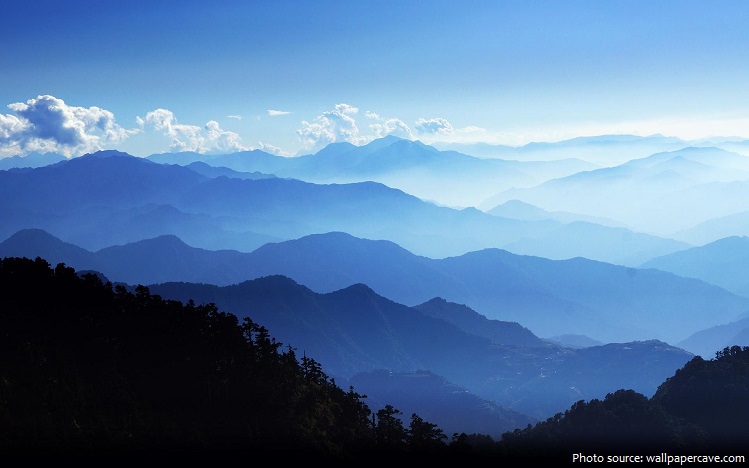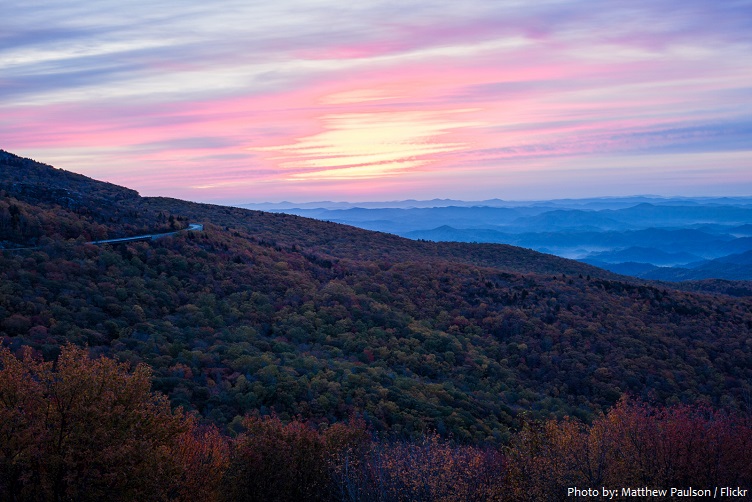The Blue Ridge Mountains are segment of the Appalachian Mountains in the eastern United States.
The mountain range stretches 990 kilometers (615 miles) and is a relatively narrow from 8 to 105 kilometers (5 to 65 miles) wide.
The Blue Ridge Mountains cross the states of Pennsylvania, Maryland, Virginia, North Carolina, South Carolina and Georgia.
About 125 peaks exceed 1,500 meters (5,000 feet) in elevation.
Included in the Blue Ridge system are the Black Mountains — with Mount Mitchell in North Carolina, at 2,037 meters (6,684 feet). Mount Mitchell is the highest peak east of the Mississippi River — and the Great Smoky and Unaka mountains.
Other notable Blue Ridge peaks include are Mount Rogers (1,746 meters / 5,729 feet), the highest point in Virginia; Sassafras Mountain (1,085 meters / 3,560 feet), the highest point in South Carolina; Brasstown Bald (1,458 meters / 4,784 feet), the highest point in Georgia; Stony Man (1,223 meters / 4,011 feet) and Hawksbill (1,235 meters / 4,051 feet), in Virginia; and Grandfather Mountain (1,812 meters / 5,946 feet), in North Carolina.
Within the range are two major national parks – the Shenandoah National Park in the northern section, and the Great Smoky Mountains National Park in the southern section.
There are also eight national forests including George Washington and Jefferson National Forests, Monongahela National Forest, Daniel Boone National Forest, Cherokee National Forest, Pisgah National Forest, Nantahala National Forest and Chattahoochee National Forest.
The Blue Ridge contains the Blue Ridge Parkway, a 755-kilometer (469-mile) long scenic highway that connects the two parks and is located along the ridge crest-lines with the Appalachian Trail.
The Blue Ridge Mountains are noted for having a bluish color when seen from a distance. Trees put the “blue” in Blue Ridge, from the isoprene released into the atmosphere, thereby contributing to the characteristic haze on the mountains and their distinctive color.
Slopes of the Blue Ridge Mountains facing the coastal Piedmont are generally steeper and more rugged than those facing the interior of the United States.
Rocks from the eastern slope are among the oldest on Earth, some exceeding 1.2 billion years and pre-dating the formation of the mountains.
These mountains were formed in three major uplift phases, the first about a billion years ago, the second perhaps some 550 million years ago, and the final one about 300 million years ago. Other uplifts that were regional in nature occurred as well. Since that time water, wind, temperature and gravity have caused the fundamental erosion that created the Blue Ridge.
The English who settled colonial Virginia in the early 17th century recorded that the native Powhatan name for the Blue Ridge was Quirank.
At the foot of the Blue Ridge, various tribes including the Siouan Manahoacs, the Iroquois, and the Shawnee hunted and fished.
Although the term “Blue Ridge” is sometimes applied exclusively to the eastern edge or front range of the Appalachian Mountains, the geological definition of the Blue Ridge province extends westward to the Ridge and Valley area, encompassing the Great Smoky Mountains, the Great Balsams, the Roans, the Blacks, the Brushy Mountains (a “spur” of the Blue Ridge) and other mountain ranges.




